Wisconsin is home to a diverse group of swallows and martins that grace the skies each spring and summer. These agile birds are known for their acrobatic flight and insect-catching skills, making them a favorite among birdwatchers. Understanding the different swallows and martins in Wisconsin can enhance your appreciation of these remarkable birds.
Among the most common species in the state are the Purple Martin, Barn Swallow, and Tree Swallow, each with unique behaviors and appearances. Additionally, species like the Cliff Swallow, Bank Swallow, and Northern Rough-winged Swallow add to the variety found in Wisconsin’s open fields, wetlands, and riverbanks. Recognizing the subtle differences between these birds is key to successful identification.
This article covers 6 swallows and martins in Wisconsin, complete with detailed descriptions and pictures to help you identify them in the wild. From rural landscapes to suburban areas, these birds provide spectacular aerial displays and play an important role in controlling insect populations during the warmer months.
Common Swallows and Martins Found in Wisconsin
Purple Martin (Progne subis)
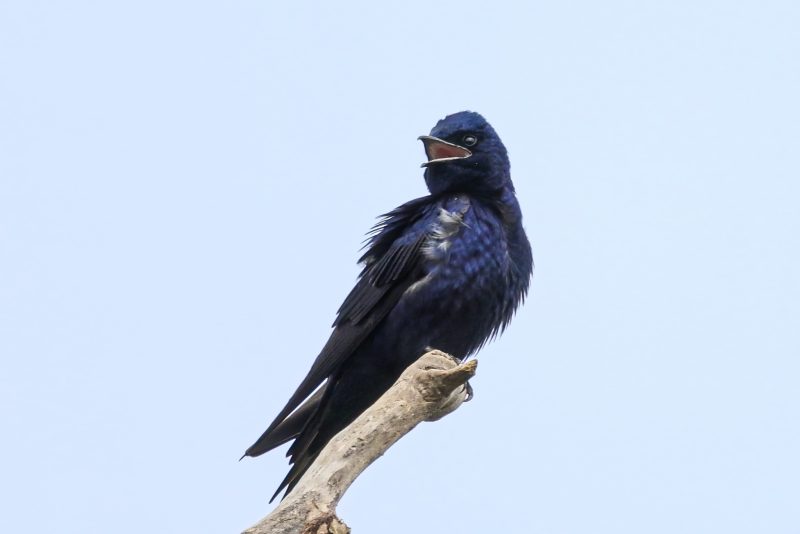
Purple Martins are the largest swallow species in North America and stand out for their striking glossy purple-black plumage. Adult males exhibit an iridescent deep purple sheen across their entire body, while females and juveniles show duller grayish tones on the underparts and wings, with some faint purplish highlights. These birds measure approximately 7 to 8 inches (18 to 20 cm) in length, making them noticeably larger than other swallows in Wisconsin. Their broad wings and robust body give them a powerful, graceful flight.
Behaviorally, Purple Martins are highly social birds, forming large colonies during the breeding season. They are almost entirely dependent on human-provided housing in the eastern U.S., including Wisconsin, as natural nesting cavities are scarce. These birds nest in multi-compartment martin houses or hanging gourds placed in open areas. Purple Martins feed exclusively on flying insects, such as dragonflies, beetles, and mosquitoes, catching them mid-air with impressive agility and speed.
In Wisconsin, Purple Martins arrive in late April or early May and remain through late summer before migrating south to Central and South America. They prefer open habitats like farmland, lakeshores, and suburban parks where martin houses are erected. Their preference for human-made structures has made them popular among bird enthusiasts who maintain special martin colonies, contributing significantly to their local population stability.
Overall, Purple Martins are a spectacular sight during summer evenings, filling the skies with aerial acrobatics. Their reliance on human-provided nesting sites means conservation efforts often focus on maintaining and monitoring martin houses. In Wisconsin, they are considered a species of interest for bird conservation groups, and their presence often marks the arrival of warmer seasons.
Barn Swallow (Hirundo rustica)
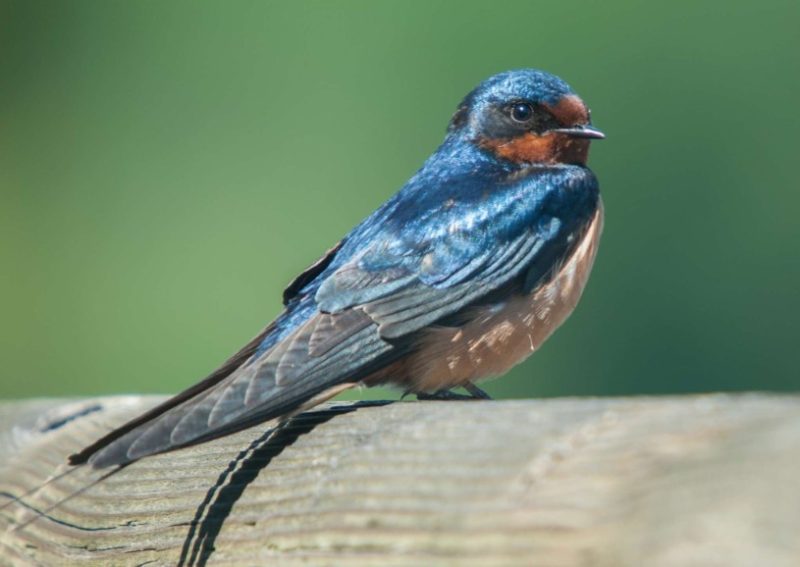
Barn Swallows are among the most recognized and widespread swallow species across Wisconsin. They are easily identified by their deeply forked tails, glossy blue upperparts, and a warm reddish-orange throat and forehead. Their underparts are creamy to light rust in color, giving them a warm, inviting appearance. Adult Barn Swallows measure about 7 to 8 inches (17 to 19 cm) in length, including their elongated tail streamers, which enhance their graceful flight.
These birds are highly aerial and feed primarily on flying insects caught during agile flight. Barn Swallows are known for their swift, acrobatic maneuvers as they pursue prey. They nest mainly on human structures such as barns, bridges, and porches, attaching their cup-shaped mud nests to beams and ledges. This close association with humans has allowed Barn Swallows to thrive in Wisconsin’s agricultural and suburban landscapes.
Barn Swallows breed across most of Wisconsin during spring and summer, arriving around April and departing by September. They prefer open habitats such as farmlands, meadows, and wetlands, often near water sources where insect abundance is high. Their adaptability to nesting on artificial structures allows them to coexist closely with human settlements, making them a common backyard and rural sight throughout the state.
The Barn Swallow’s widespread presence and cheerful aerial displays have made it a favorite among birdwatchers and farmers alike. While their populations have shown some decline due to changes in farming practices and pesticide use, they remain one of Wisconsin’s most familiar and cherished swallow species.
Tree Swallow (Tachycineta bicolor)
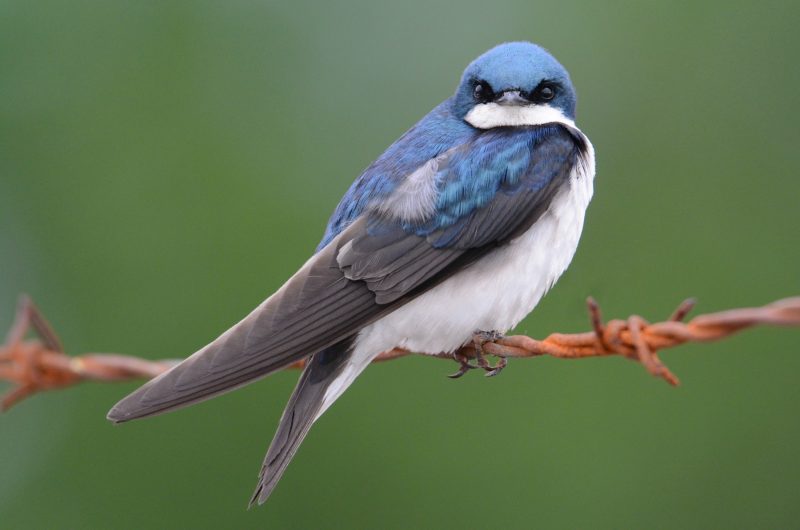
Tree Swallows are medium-sized swallows easily recognized by their striking metallic blue-green upperparts and pure white underparts. Adults measure about 5.5 to 6 inches (14 to 16 cm) in length with a wingspan of approximately 11 to 13 inches. Females and juveniles appear slightly duller with more grayish tones but maintain the distinctive white chest and belly. Their clean, contrasting coloration makes them one of the most visually appealing swallow species in Wisconsin.
Tree Swallows primarily feed on flying insects such as flies, mosquitoes, and gnats, which they catch during swift, graceful flights over wetlands, lakes, and open fields. They nest in natural tree cavities or nest boxes placed near water bodies. Unlike other swallows, Tree Swallows do not build mud nests but instead line their cavities with feathers and soft materials, sometimes scavenging feathers from other birds.
In Wisconsin, Tree Swallows arrive in early spring, often as soon as ice melts on lakes and wetlands, and they stay through summer to raise one or two broods. Their habitat preferences include open wetlands, marshes, and lake shores, where abundant insects provide ample food. They are commonly seen perched on fence posts or power lines near water, scanning for prey.
Tree Swallows are highly social during migration and roost in large communal groups during the non-breeding season. Their spectacular aerial displays and ability to thrive in man-made nest boxes have made them popular among conservationists and bird enthusiasts in Wisconsin. They are considered a success story in bird conservation due to their adaptability and widespread distribution.
Cliff Swallow (Petrochelidon pyrrhonota)
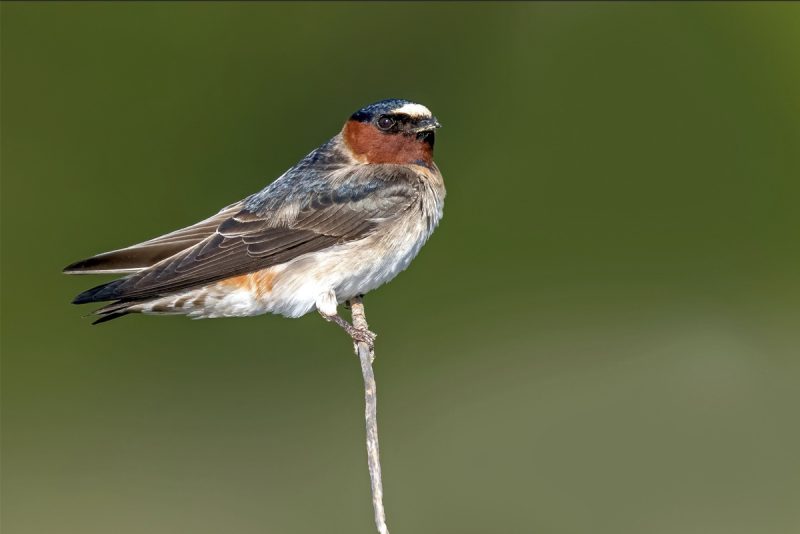
Cliff Swallows are known for their distinctive gregarious behavior and unique mud nests that resemble upside-down cups attached to vertical surfaces. These birds are about 5.5 to 6 inches (14 to 15 cm) long, with a chunky body, short tail, and a square-shaped tail end. Their plumage includes a dark blue back, pale rump, creamy underparts, and a rusty reddish throat and forehead. This combination of colors and their colony-nesting habits make them easy to identify in Wisconsin.
Cliff Swallows feed almost exclusively on flying insects, catching them on the wing with rapid, flapping flight patterns. They are highly social and nest in large colonies, often numbering in the hundreds or thousands. Their nests are built from small pellets of mud, which they gather with their bills and shape carefully. In Wisconsin, they often build colonies under bridges, cliffs, road overpasses, and the eaves of buildings.
These swallows arrive in Wisconsin in late April or early May and remain through the summer to raise their young. They prefer open landscapes near water where insect prey is abundant and suitable nesting sites are available. The presence of large, stable colonies is a characteristic feature of this species and an important part of Wisconsin’s swallow diversity.
Cliff Swallows’ highly social nesting behavior can sometimes lead to conflicts with humans due to their messy colonies, but their ecological role in controlling insect populations is significant. In Wisconsin, they continue to thrive in both rural and semi-urban environments where mud and nesting surfaces are accessible.
Bank Swallow (Riparia riparia)
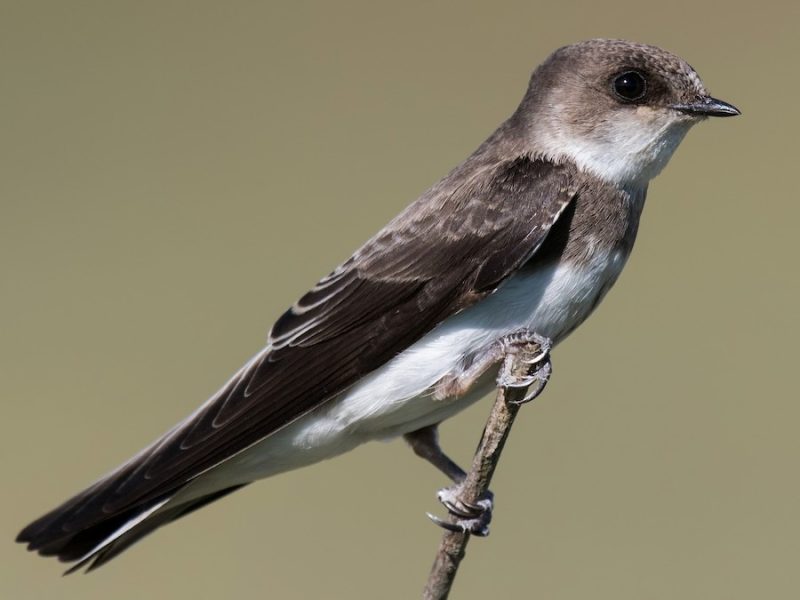
Bank Swallows are small, slender swallows measuring about 5 inches (12 to 13 cm) in length. They are easily recognized by their brown upperparts, white underparts, and a distinctive dark breast band that sets them apart from other swallows. Their tail is short and slightly notched, and their wings are pointed, making them agile fliers. Bank Swallows have a relatively short bill compared to other swallow species.
These birds specialize in nesting in vertical sandy or earthen banks, where they excavate burrows for their nests. In Wisconsin, they are often found along riverbanks, sand pits, lakeshores, and gravel quarries. Bank Swallows feed on small flying insects caught in flight and sometimes forage low over water surfaces or fields. Their flight is swift and direct, often closer to the ground than other swallows.
Bank Swallows migrate to Wisconsin in spring and stay through summer to breed. They are considered colonial nesters, often forming loose colonies of burrows clustered in suitable banks. Their preference for natural earth banks means that changes in river management or erosion control can impact their nesting success.
While less conspicuous than some other swallow species, Bank Swallows play an important ecological role in controlling insect populations in Wisconsin. Their nesting habits make them vulnerable to habitat disturbance, so conservation efforts often focus on protecting nesting sites and suitable banks.
Northern Rough-winged Swallow (Stelgidopteryx serripennis)
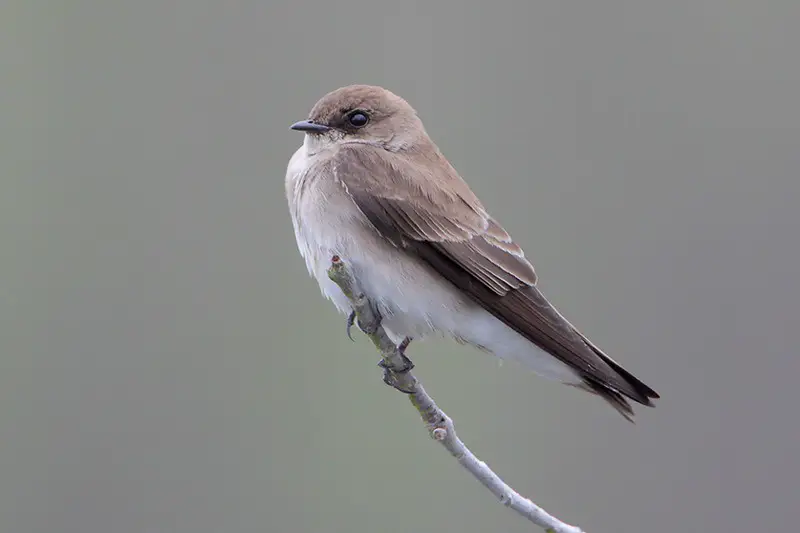
Northern Rough-winged Swallows are medium-sized, plain-looking swallows measuring about 5.5 to 6 inches (14 to 15 cm) long. Their upperparts are dull brown, and their underparts are pale grayish-white, lacking the bright colors of other swallows. Their tail is short and slightly rounded, and their wings are long and pointed. The species gets its name from the rough texture of the outer wing feathers on males, which are visible only up close.
These swallows are less social than other species, often nesting singly or in small loose groups. They nest in natural cavities such as crevices in cliffs, rock walls, or tunnels made by other animals, including abandoned burrows. In Wisconsin, they also use nest boxes and man-made structures near water. Northern Rough-winged Swallows feed on flying insects caught during flight, usually flying low over streams, ponds, or open fields.
They arrive in Wisconsin in early spring and remain through the summer months to breed, favoring habitats near water bodies with open areas for feeding. Their inconspicuous coloration helps them blend into rocky or wooded environments, making them less noticeable than other more colorful swallow species.
Despite their understated appearance, Northern Rough-winged Swallows are important insect predators and contribute to the diversity of swallow species in Wisconsin. They are adaptable to human-altered landscapes and often nest near bridges, culverts, and buildings, adding to the state’s rich birdlife.
FAQ About Swallows and Martins in Wisconsin
What swallow and martin species are commonly found in Wisconsin?
The most commonly seen species in Wisconsin include the Purple Martin, Barn Swallow, Tree Swallow, Cliff Swallow, Bank Swallow, and Northern Rough-winged Swallow. These birds are mostly observed during the spring and summer months when they are breeding and raising their young.
When do swallows and martins arrive in Wisconsin?
Swallows and martins typically arrive in Wisconsin between late March and early May, depending on the species and local weather conditions. They remain through the breeding season and usually begin their migration southward in late summer or early fall.
Where do swallows and martins nest in Wisconsin?
Purple Martins usually nest in human-made martin houses or gourds placed in open areas. Barn Swallows build mud cup-shaped nests on buildings, bridges, and similar structures. Tree Swallows use tree cavities or nest boxes often located near water bodies. Cliff Swallows create large colonies of mud nests under bridges or on cliffs. Bank Swallows dig burrows in vertical sandy or earthen banks, often along rivers or lakeshores. Northern Rough-winged Swallows prefer cavities or crevices near water, and sometimes use nest boxes as well.
What do swallows and martins eat?
These birds feed mainly on flying insects, including flies, mosquitoes, beetles, and dragonflies, which they catch during fast and agile flight. Their insectivorous diet plays an important role in controlling pest populations in Wisconsin.
Are swallows and martins social birds?
Many species such as Purple Martins, Cliff Swallows, and Bank Swallows nest in large colonies that can number in the hundreds or thousands. Other species like the Northern Rough-winged Swallow tend to be more solitary or nest in smaller groups.
How can I attract swallows and martins to my yard in Wisconsin?
Attracting these birds can be achieved by providing appropriate nesting sites like martin houses or nest boxes. Avoiding the use of pesticides helps maintain a healthy insect population for food. Additionally, having a clean water source and planting native flowers that support insect life encourages swallows and martins to visit.
Are any swallow or martin species in Wisconsin considered threatened or declining?
While most of these species are still common in Wisconsin, some, including Barn Swallows and Bank Swallows, have experienced population declines in parts of their range. These declines are often linked to habitat loss and pesticide use. Conservation efforts are important to protect nesting habitats and promote safe environments for these birds.






